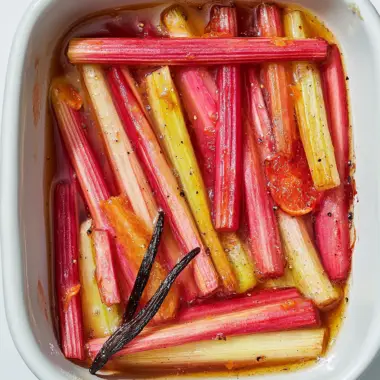These Rhubarb Scones with Lemon Drizzle are a celebration of seasonal freshness and cozy baking. Tart rhubarb chunks are nestled inside a buttery, crumbly dough, giving every bite a burst of flavor. Topped with a sweet, citrusy glaze made from fresh lemon juice and zest, these scones strike the perfect balance between tangy and sweet. The crisp edges and tender centers make them a must-have for brunch tables and afternoon tea spreads. They’re especially delightful in the spring and early summer months when rhubarb is at its peak. Whether you serve them warm with clotted cream or enjoy them plain with coffee, these scones are easy to make and even easier to love. Their rustic charm makes them perfect for casual gatherings, gifting, or indulging in a solo treat. The aroma alone will have everyone flocking to the kitchen.
Full Recipe:
Ingredients:
-
2 cups all-purpose flour
-
1/3 cup granulated sugar
-
1 tablespoon baking powder
-
1/2 teaspoon salt
-
1/2 cup cold unsalted butter, cubed
-
3/4 cup heavy cream
-
1 large egg
-
1 teaspoon vanilla extract
-
1 1/2 cups chopped fresh rhubarb
For the Lemon Glaze:
-
1 cup powdered sugar
-
2 tablespoons freshly squeezed lemon juice
-
1/2 teaspoon lemon zest
Directions:
-
Preheat the oven to 400°F (200°C). Line a baking sheet with parchment paper.
-
In a large bowl, whisk together the flour, sugar, baking powder, and salt.
-
Cut in the cold butter with a pastry cutter or your fingertips until the mixture resembles coarse crumbs.
-
In a small bowl, whisk the cream, egg, and vanilla. Add to the dry ingredients and mix just until combined.
-
Fold in the chopped rhubarb.
-
Turn the dough onto a floured surface, gently knead a few times, and pat into a 1-inch-thick circle.
-
Cut into 8 wedges and place on the prepared baking sheet.
-
Bake for 18–22 minutes or until golden brown.
-
In a small bowl, mix powdered sugar, lemon juice, and zest until smooth.
-
Once the scones are slightly cooled, drizzle the lemon glaze over the top.
Prep Time: 15 minutes | Cooking Time: 22 minutes | Total Time: 37 minutes
Kcal: 310 kcal | Servings: 8 scones
Discover the Delight of Rhubarb Scones with Lemon Glaze
Rhubarb scones with lemon glaze are a timeless treat that balances tart and sweet flavors in a buttery, tender pastry. These baked goods are more than just scones they’re an invitation to enjoy the best of seasonal produce in a form that feels cozy and refined all at once. Whether served for brunch, breakfast, tea time, or even dessert, these scones are guaranteed to become a favorite. In this article, we’ll dive into what makes this recipe so special, explore its versatility, discuss the magic of rhubarb, and provide helpful tips for bakers of all levels.
Why Rhubarb is the Star Ingredient
Rhubarb, often misunderstood as a fruit due to its sweet-tart flavor and common use in desserts, is technically a vegetable. Its stalks have a distinct tanginess that shines when sweetened appropriately, making them perfect for baked goods. Rhubarb is especially prominent in spring and early summer, offering a fresh and vibrant ingredient when many fruits are still out of season.
What makes rhubarb ideal for scones is its unique texture. When chopped and baked, it becomes tender but retains enough structure to provide a juicy bite that contrasts beautifully with the crumbly nature of the scone. Its bright pink and red hues also add visual appeal, making your baked goods look as delightful as they taste.
The Balance of Flavors: Sweet Meets Tart
Rhubarb on its own is very tart, which is why the addition of a lemon glaze might seem counterintuitive. However, lemon in baking often plays a dual role: it enhances flavors and provides brightness that lifts heavier, buttery items like scones. In this recipe, the lemon glaze doesn’t add an overpowering sour note but rather a thin, sweet finish with just a hint of zest to elevate each bite.
The result is a scone that doesn’t feel cloying or overly rich. The sweetness of the glaze complements the tartness of the rhubarb while also highlighting the depth of the scone’s buttery base. It’s a symphony of contrasts soft and crumbly, tart and sweet, rustic and elegant.
A Scone for Every Occasion
One of the great joys of baking scones is their versatility. These rhubarb scones can be served in a variety of settings:
-
Breakfast Treat: Warm and hearty, a rhubarb scone pairs beautifully with coffee or tea in the morning.
-
Afternoon Tea: Elevate your tea experience with a tray of these glazed scones and a side of clotted cream or mascarpone.
-
Brunch Table Favorite: Bring a touch of rustic charm and homemade comfort to a brunch spread.
-
Sweet Snack or Dessert: Enjoy with a scoop of vanilla ice cream or some whipped cream for a light dessert.
Scones also store well, making them great for preparing in advance or enjoying over several days. Their structure holds up beautifully, and they can even be frozen before baking for fresh scones on demand.
Texture and Technique
Unlike fluffy muffins or dense biscuits, scones are known for their crumbly, slightly crisp exterior and tender, moist interior. Achieving the perfect scone texture requires attention to detail but is entirely manageable with a few essential tips.
The most crucial element is cold butter. When small bits of chilled butter are incorporated into the flour, they create steam as the scones bake, resulting in flaky layers and a light, airy crumb. Overmixing can lead to toughness, so handling the dough gently is key. A light knead and a quick shape are all that’s needed before cutting and baking.
The addition of cream in the dough ensures richness, while the egg helps with structure and browning. Rhubarb should be chopped uniformly to ensure even baking, and folding it in gently preserves both the dough’s integrity and the fruit’s shape.
The Role of the Lemon Glaze
The lemon glaze might be the simplest part of the recipe, but it adds a transformative finish. Just a few ingredients powdered sugar, fresh lemon juice, and zest are whisked together to form a smooth, pourable glaze. Once the scones are slightly cooled, this mixture is drizzled on top, hardening slightly as it sits.
The glaze not only enhances flavor but also adds a glistening, bakery-style appearance that makes the scones look polished and inviting. For those who prefer a subtler sweetness, the glaze can be applied lightly or even served on the side.
Baking with the Seasons
Recipes like this one highlight the importance of seasonal baking. Rhubarb is typically in peak season from April through June, making these scones an ideal way to celebrate spring produce. Seasonal baking not only supports local agriculture but also ensures the best flavor and texture in your ingredients.
During other seasons, you can substitute or complement the rhubarb with other fruits such as strawberries, blueberries, or apples. However, the unique tartness of rhubarb is hard to replicate, and its return each spring is a welcome sign for many home bakers.
Perfect for Sharing
Few things evoke warmth and hospitality like a tray of freshly baked scones. These rhubarb scones are perfect for gifting whether wrapped in parchment and tied with twine or presented in a bakery box with a note. They’re also an excellent contribution to potlucks, bake sales, and family gatherings.
If you’re entertaining, consider serving them with lemon curd, honey, or whipped cream to create a small scone bar. This allows guests to personalize their treat while showcasing the versatility of this humble bake.
Storage and Serving Suggestions
These scones are best enjoyed fresh out of the oven, but they can be stored at room temperature in an airtight container for up to two days. To revive their crisp edges, a quick reheat in the oven or toaster oven works wonders.
If you want to prepare in advance, you can freeze the unbaked scone wedges and bake them directly from frozen just add a few minutes to the baking time. The glaze can be applied after baking, once the scones have cooled slightly.
Serve with:
-
Fresh berries for a spring-themed plate
-
Clotted cream or whipped ricotta
-
Herbal tea or citrusy coffee for flavor harmony
Conclusion:
Rhubarb scones with lemon glaze are a delightful fusion of rustic baking and refined flavor pairing. The tartness of the rhubarb and the brightness of lemon bring a lively energy to a traditional scone recipe, making it something special. It’s the kind of treat that feels both nostalgic and fresh, comforting yet sophisticated.
This recipe not only celebrates the fleeting season of rhubarb but also serves as a reminder of how simple ingredients flour, butter, sugar, cream can come together to create something truly memorable. Whether you’re a seasoned baker or just beginning your baking journey, these scones are a perfect project. They’re forgiving, flavorful, and always crowd-pleasing.








